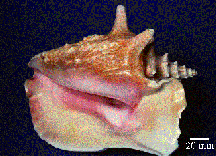Conch yields clues for future materials
- More than 2 years ago
The shell of the giant pink queen conch evolved over millions of years into the perfect haven. Now, researchers have probed the mollusk shell’s mysterious inner architecture in such detail that they can say just why it’s hard to crack. Their work hints at how people, too, could construct light, tough protective materials.

The conch Strombus gigas can resist fracture a hundred to a thousand times better than the mineral that makes up 99 percent of its shell. Called aragonite, this mineral is a form of calcium carbonate that breaks like chalk. The researchers used microscopy to show that a protein surrounds the aragonite crystals throughout the shell. That protein changes the toughness by permitting fractures to spread without shattering the mineral.
“What’s really remarkable about these conch shells is that the organisms have made very, very tough materials using quite mundane raw materials,” says Arthur H. Heuer. He and his colleagues at Case Western Reserve University in Cleveland describe their findings in the June 29 Nature.
The researchers have shown how the conch’s complex arrangement of aragonite structures and protein resists fractures. Instead of producing one catastrophic crack, the system responds to weak stress by scattering many fractures along lines of protein in the outer or inner of three shell layers.
Under heavier loads, the tough middle layer deters cracks from piercing the shell. This layer’s strength comes from the arrangement of the mineral. The basic building block is a rectangular beam of aragonite surrounded by protein. These beams are bundled into larger beams, which are packed into still larger structures.
At each of these levels of organization, adjacent structures are oriented perpendicular to one another. A crack following a protein-lined boundary within the middle layer encounters a wall of aragonite when it reaches a neighboring structure. Fractures penetrate alternating structures, while the bridges hold the layer together.
With physical testing and computer simulations, the researchers have developed fracture models predicting the forces at which the conch structure cracks. Their calculations also indicate how much energy different layers of architecture release when they fracture.
Coauthor Roberto Ballarini says that to analyze the protein’s role further, the group is now examining the effects of extreme temperatures on shell strength.
“We believe that we could eventually make better materials by looking at nature and really getting close to natural designs,” says Ballarini. Materials scientists look for strong, lightweight ceramics for high-stress situations.
“Making a composite material is expensive,” says team member Shekhar Kamat. “You have to justify why you’re making it and how much advantage you’re getting.” The conch shell illustrates various composite-toughening phenomena, he says.
“This is an elegant study pinpointing the mechanisms responsible for the tremendous mechanical advantage and fracture toughness of the conch shell,” comments Daniel E. Morse of the University of California, Santa Barbara. “Applications of this [type of] high-performance structure should be useful in aerospace vehicles, bridges, construction materials, and military uses.”







